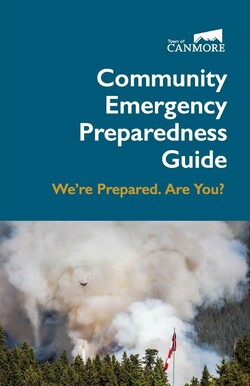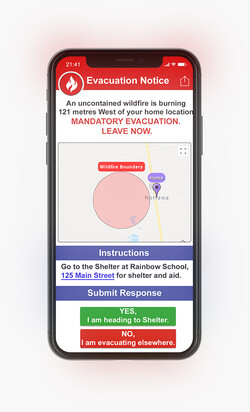Know the Risks
While you cannot always predict when a disaster strikes or how much damage it can cause, knowing and understanding the risks and hazards most relevant to Canmore and the wider Bow Valley will help you better prepare and plan for an emergency.
The most significant risks to Canmore are flooding from steep mountainous creeks, flooding from the Bow River, wildfire, and drought. Canmore is heavily developed in flood plains and well into the natural environment; as our community and lifestyles grow and extend further into forested areas, we are increasingly vulnerable to our most significant risks. Canada is also warming much faster than the rest of the world, influencing the frequency and intensity of natural hazards, including floods, wildfires, droughts, severe storms, and extreme heat events.
You can stay up to date on the current risk levels of Canmore’s hazards by visiting the Town of Canmore's hazard monitoring page. Hazards are monitored weekly during the peak hazard season (March – October).
Stay Informed
One of the most important things you’ll need during an emergency is information. In the case of an emergency, follow official channels and look for updates from the Town of Canmore on:
- Voyent Alert!
- canmore.ca/emergency
- Town of Canmore's Facebook page
- Local media including Rocky Mountain Outlook and 106.5 Mountain FM (keep radio and batteries on hand)
- Alberta Emergency Alerts (if life-threatening)

Be Prepared
Do you know what you would do if you had a single hour to evacuate in the case of an emergency? What would you do first?
Prepared people create resilient communities. Read the Town of Canmore's Community Emergency Preparedness Guide to learn about what you can do to prepare for an emergency, and what you can expect during an emergency.

Subscribe to Voyent Alert!
Voyent Alert! is an emergency alerting system used by the Town of Canmore, Town of Banff, and the MD of Bighorn. If the Town of Canmore is under an emergency or disaster watch, or if there is an active emergency or disaster, communications about what you need to know and what you need to do will be issued through Voyent Alert!
How to Register:
Registration for the service is FREE, simple and totally anonymous.
- For Mobile App Alerts: Download and install the Voyent Alert! app from the Apple or Google Play app stores.
- For Email, Text Message or Voice Call Alerts: Register online at https://register.voyent-alert.com
Know Your Zone
| Evacuation Types |
Description |
| EVACUATION ALERT |
You should be prepared to evacuate soon if the situation worsens. An alert can lead to an evacuation order.
|
| EVACUATION ORDER |
You must evacuate now. Always obey an evacuation order if one is issued. Failing to do so put your life and the lives of first responders at risk. Evacuation orders are issued when you are in danger.
|
| SHELTER IN PLACE |
Find a safe location indoors and stay there. A recommendation to shelter-in-place may be used when an evacuation is not necessary or would pose a greater safety risk. |
We will not ask you to leave your house unless there is reason to believe you are in danger. If you are ordered to evacuate, please do so, and either go to the reception centre that will be set up, or an alternative safe place to stay.
Take your emergency kit, essential medications, copies of prescriptions, personal identification of each family member, and a cellular phone with you. Take pets with you, lock your home, and use travel routes specified. Stay informed using the channels outlined above.
Following Emergency Orders
When an emergency exists, sometimes residents are asked to take action to ensure that everyone, including residents and emergency personnel, is kept safe. If orders are issued, please follow them. They are issued for the safety of everyone involved.
Your strongest resource during an emergency event, large or small, is your neighbours. Building relationships with your neighbours will help you form strong networks and cope during an emergency. Strong and connected neighbourhoods and communities are more resilient and recover more quickly following emergencies.
Here are some ways to connect as neighbours and become more prepared:
- Create a neighbourhood map identifying a muster station and people with pets, skills, and resources. Also note who may require extra assistance.
- Learn together! Organize a first aid course for those interested in your neighbourhood.
- Create a neighbourhood tool library of supplies you can share everyday and during and emergency
- Save money by bulk purchasing emergency supplies and kits together
